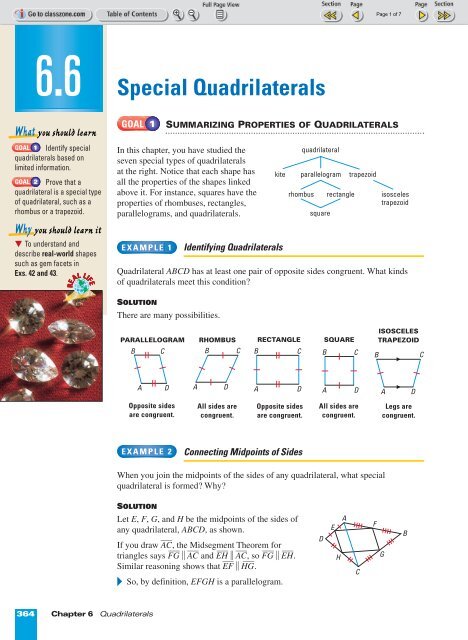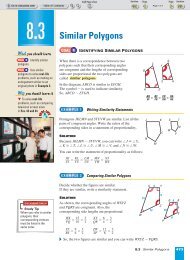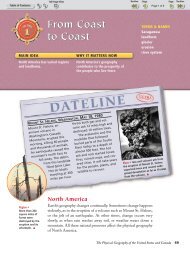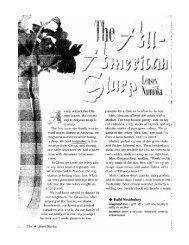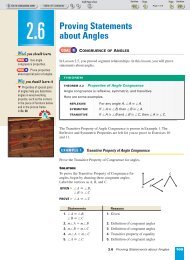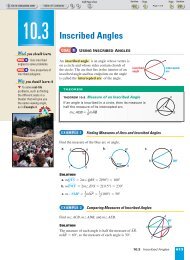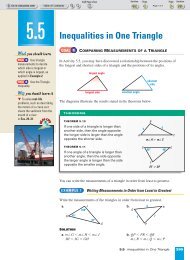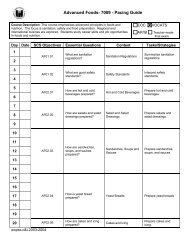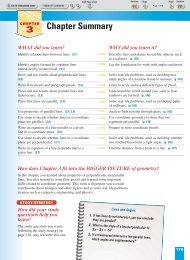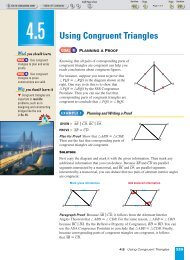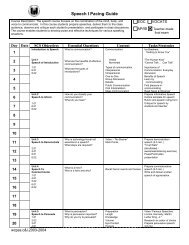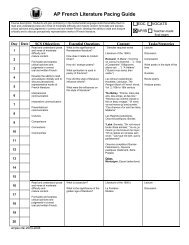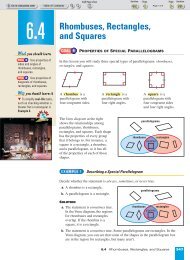Special Quadrilaterals - Nexuslearning.net
Special Quadrilaterals - Nexuslearning.net
Special Quadrilaterals - Nexuslearning.net
Create successful ePaper yourself
Turn your PDF publications into a flip-book with our unique Google optimized e-Paper software.
6.6<br />
What you should learn<br />
GOAL 1 Identify special<br />
quadrilaterals based on<br />
limited information.<br />
GOAL 2 Prove that a<br />
quadrilateral is a special type<br />
of quadrilateral, such as a<br />
rhombus or a trapezoid.<br />
Why you should learn it<br />
To understand and<br />
describe real-world shapes<br />
such as gem facets in<br />
Exs. 42 and 43.<br />
REAL<br />
REAL LIFE<br />
LIFE<br />
364 Chapter 6 <strong>Quadrilaterals</strong><br />
<strong>Special</strong> <strong>Quadrilaterals</strong><br />
GOAL 1<br />
SUMMARIZING PROPERTIES OF QUADRILATERALS<br />
In this chapter, you have studied the<br />
seven special types of quadrilaterals<br />
at the right. Notice that each shape has<br />
all the properties of the shapes linked<br />
above it. For instance, squares have the<br />
properties of rhombuses, rectangles,<br />
parallelograms, and quadrilaterals.<br />
EXAMPLE 1<br />
Identifying <strong>Quadrilaterals</strong><br />
Quadrilateral ABCD has at least one pair of opposite sides congruent. What kinds<br />
of quadrilaterals meet this condition?<br />
SOLUTION<br />
There are many possibilities.<br />
EXAMPLE 2<br />
Connecting Midpoints of Sides<br />
When you join the midpoints of the sides of any quadrilateral, what special<br />
quadrilateral is formed? Why?<br />
SOLUTION<br />
Let E, F, G, and H be the midpoints of the sides of<br />
any quadrilateral, ABCD, as shown.<br />
If you draw AC Æ , the Midsegment Theorem for<br />
triangles says FG Æ ∞ AC Æ and EH Æ ∞ AC Æ , so FG Æ ∞ EH Æ .<br />
Similar reasoning shows that EF<br />
Æ ∞ HG Æ .<br />
So, by definition, EFGH is a parallelogram.<br />
quadrilateral<br />
kite parallelogram trapezoid<br />
rhombus rectangle isosceles<br />
trapezoid<br />
square<br />
PARALLELOGRAM RHOMBUS RECTANGLE SQUARE<br />
B C<br />
A<br />
Opposite sides<br />
are congruent.<br />
B C<br />
D A D A D<br />
All sides are<br />
congruent.<br />
B C<br />
Opposite sides<br />
are congruent.<br />
D<br />
B C<br />
A D<br />
All sides are<br />
congruent.<br />
E<br />
H<br />
A<br />
C<br />
F<br />
ISOSCELES<br />
TRAPEZOID<br />
B C<br />
A D<br />
Legs are<br />
congruent.<br />
G<br />
B
STUDENT HELP<br />
Look Back<br />
For help with proving<br />
a quadrilateral is a<br />
parallelogram, see<br />
pp. 338–341.<br />
GOAL 2<br />
PROOF WITH SPECIAL QUADRILATERALS<br />
When you want to prove that a quadrilateral has a specific shape, you can use<br />
either the definition of the shape as in Example 2, or you can use a theorem.<br />
CONCEPT<br />
SUMMARY<br />
EXAMPLE 3<br />
Show that KLMN is a rhombus.<br />
Proving a Quadrilateral is a Rhombus<br />
SOLUTION You can use any of the three ways described in the concept summary<br />
above. For instance, you could show that opposite sides have the same slope and<br />
that the diagonals are perpendicular. Another way, shown below, is to prove that<br />
all four sides have the same length.<br />
LM = [2 º (º 2)] 2+ (1 º 3) 2 <br />
= 4 2 + (º2) 2 <br />
= 20<br />
MN = (6 º 2) 2 + (3 º 1) 2 <br />
= 4 2 + 2 2 <br />
= 20<br />
PROVING QUADRILATERALS ARE RHOMBUSES<br />
You have learned three ways to prove that a quadrilateral is a rhombus.<br />
1. You can use the definition and show that the quadrilateral is a<br />
parallelogram that has four congruent sides. It is easier, however, to use<br />
the Rhombus Corollary and simply show that all four sides of the<br />
quadrilateral are congruent.<br />
2. Show that the quadrilateral is a parallelogram and that the diagonals are<br />
perpendicular. (Theorem 6.11)<br />
3. Show that the quadrilateral is a parallelogram and that each diagonal<br />
bisects a pair of opposite angles. (Theorem 6.12)<br />
L(2, 3)<br />
NK = (2 º 6) 2 + (5 º 3) 2 <br />
= (º4) 2 + 2 2 <br />
= 20<br />
KL = (º2 º2) 2 + (3 º 5) 2 <br />
= (º4) 2 + (º2) 2 <br />
= 20<br />
So, because LM = NK = MN = KL, KLMN is a rhombus.<br />
1<br />
y<br />
1<br />
K(2, 5)<br />
M(2, 1)<br />
N(6, 3)<br />
x<br />
6.6 <strong>Special</strong> <strong>Quadrilaterals</strong> 365
Proof<br />
EXAMPLE 4<br />
366 Chapter 6 <strong>Quadrilaterals</strong><br />
Identifying a Quadrilateral<br />
What type of quadrilateral is ABCD?<br />
Explain your reasoning.<br />
SOLUTION<br />
A and D are supplementary, but A and B are not.<br />
So, AB<br />
Æ ∞ DC Æ but AD Æ is not parallel to BC Æ . By definition,<br />
ABCD is a trapezoid. Because base angles are congruent,<br />
ABCD is an isosceles trapezoid.<br />
EXAMPLE 5<br />
Identifying a Quadrilateral<br />
The diagonals of quadrilateral ABCD intersect at point N to produce four<br />
congruent segments: AN Æ £ BN Æ £ CN Æ £ DN Æ . What type of quadrilateral is<br />
ABCD? Prove that your answer is correct.<br />
SOLUTION<br />
Draw a diagram:<br />
Draw the diagonals as described. Then connect<br />
the endpoints to draw quadrilateral ABCD.<br />
Make a conjecture:<br />
Quadrilateral ABCD looks like a rectangle.<br />
Prove your conjecture:<br />
GIVEN AN Æ £ BN Æ £ CN Æ £ DN Æ<br />
PROVE ABCD is a rectangle.<br />
Paragraph Proof Because you are given information about the diagonals, show<br />
that ABCD is a parallelogram with congruent diagonals.<br />
First prove that ABCD is a parallelogram.<br />
Because BN Æ £ DN Æ and AN Æ £ CN Æ , BD Æ and AC Æ bisect each other. Because the<br />
diagonals of ABCD bisect each other, ABCD is a parallelogram.<br />
Then prove that the diagonals of ABCD are congruent.<br />
From the given you can write BN = AN and<br />
DN = CN so, by the Addition Property of<br />
Equality, BN + DN = AN + CN. By the<br />
Segment Addition Postulate, BD = BN + DN<br />
and AC = AN + CN so, by substitution,<br />
BD = AC.<br />
So, BD Æ £ AC Æ B<br />
N<br />
A<br />
D<br />
.<br />
ABCD is a parallelogram with congruent diagonals, so ABCD is a rectangle.<br />
A<br />
A<br />
60<br />
B<br />
N<br />
B<br />
60<br />
120<br />
D<br />
120 C<br />
D<br />
C<br />
C
GUIDED PRACTICE<br />
Concept Check ✓<br />
Skill Check ✓<br />
1. In Example 2, explain how to prove that EF<br />
Æ ∞ HG Æ .<br />
Copy the chart. Put an X in the box if the shape always has the given property.<br />
2.<br />
3.<br />
4.<br />
5.<br />
6.<br />
PRACTICE AND APPLICATIONS<br />
STUDENT HELP<br />
Extra Practice<br />
to help you master<br />
skills is on p. 814.<br />
FOCUS ON<br />
APPLICATIONS<br />
Tents are designed<br />
differently for<br />
different climates. For<br />
example, winter tents are<br />
designed to shed snow.<br />
Desert tents can have flat<br />
roofs because they don’t<br />
need to shed rain.<br />
LIFE<br />
LIFE<br />
REAL<br />
REAL<br />
7. Which quadrilaterals can you form with four sticks of the same length? You<br />
must attach the sticks at their ends and cannot bend or break any of them.<br />
PROPERTIES OF QUADRILATERALS Copy the chart. Put an X in the box if<br />
the shape always has the given property.<br />
8.<br />
9.<br />
10.<br />
11.<br />
12.<br />
13.<br />
Property ⁄ Rectangle Rhombus Square Kite Trapezoid<br />
Both pairs of<br />
opp. sides are ∞.<br />
Exactly 1 pair of<br />
opp. sides are ∞.<br />
TENT SHAPES What kind of special quadrilateral is the red shape?<br />
14. 15.<br />
? ? ? ? ? ?<br />
? ? ? ? ? ?<br />
Diagonals are fi. ? ? ? ? ? ?<br />
Diagonals are £. ? ? ? ? ? ?<br />
Diagonals bisect<br />
each other.<br />
? ? ? ? ? ?<br />
Property ⁄ Rectangle Rhombus Square Kite Trapezoid<br />
Both pairs of<br />
opp. sides are £.<br />
Exactly 1 pair of<br />
opp. sides are £.<br />
? ? ? ? ? ?<br />
? ? ? ? ? ?<br />
All sides are £. ? ? ? ? ? ?<br />
Both pairs of opp.<br />
√ are £.<br />
? ? ? ? ? ?<br />
Exactly 1 pair of opp.<br />
√ are £.<br />
? ? ? ? ? ?<br />
All √ are £. ? ? ? ? ? ?<br />
6.6 <strong>Special</strong> <strong>Quadrilaterals</strong> 367
STUDENT HELP<br />
HOMEWORK HELP<br />
Example 1: Exs. 8–24,<br />
30–35<br />
Example 2: Exs. 14–18,<br />
42–44<br />
Example 3: Exs. 25–29,<br />
36–41<br />
Example 4: Exs. 14–18,<br />
42, 43<br />
Example 5: Exs. 45–47<br />
STUDENT HELP<br />
Study Tip<br />
See the summaries for<br />
parallelograms and<br />
rhombuses on pp. 340<br />
and 365, and the list of<br />
postulates and theorems<br />
on pp. 828–837. You can<br />
refer to your summaries<br />
as you do the rest of the<br />
exercises.<br />
368 Chapter 6 <strong>Quadrilaterals</strong><br />
IDENTIFYING QUADRILATERALS Identify the special quadrilateral. Use the<br />
most specific name.<br />
16. 17. 18.<br />
IDENTIFYING QUADRILATERALS What kinds of quadrilaterals meet the<br />
conditions shown? ABCD is not drawn to scale.<br />
19. B<br />
C<br />
20. B<br />
C<br />
21.<br />
A<br />
22. A B 23. A<br />
24. A<br />
B<br />
DESCRIBING METHODS OF PROOF Summarize the ways you have learned<br />
to prove that a quadrilateral is the given special type of quadrilateral.<br />
25. kite 26. square 27. rectangle<br />
28. trapezoid 29. isosceles trapezoid<br />
DEVELOPING PROOF Which two segments or angles must be<br />
congruent to enable you to prove ABCD is the given quadrilateral? Explain<br />
your reasoning. There may be more than one right answer.<br />
30. isosceles trapezoid 31. parallelogram 32. rhombus<br />
A<br />
33. rectangle 34. kite 35. square<br />
B C<br />
A<br />
B<br />
70<br />
110<br />
E<br />
D<br />
D C<br />
C<br />
D<br />
D<br />
A<br />
D<br />
A<br />
A<br />
B<br />
B<br />
D<br />
B C<br />
QUADRILATERALS What kind of quadrilateral is PQRS? Justify your answer.<br />
36. P(0, 0), Q(0, 2), R(5, 5), S(2, 0) 37. P(1, 1), Q(5, 1), R(4, 8), S(2, 8)<br />
38. P(2, 1), Q(7, 1), R(7, 7), S(2, 5) 39. P(0, 7), Q(4, 8), R(5, 2), S(1, 1)<br />
40. P(1, 7), Q(5, 9), R(8, 3), S(4, 1) 41. P(5, 1), Q(9, 6), R(5, 11), S(1, 6)<br />
E<br />
D<br />
D<br />
C<br />
C<br />
C<br />
D<br />
A<br />
A<br />
A B<br />
D C<br />
B<br />
E<br />
D<br />
D<br />
C<br />
B<br />
C
GEMOLOGISTS<br />
analyze the cut of<br />
a gem when determining<br />
its value.<br />
CAREER LINK<br />
www.mcdougallittell.com<br />
REAL<br />
REAL LIFE<br />
LIFE<br />
INTERNET<br />
FOCUS ON<br />
CAREERS<br />
STUDENT HELP<br />
HOMEWORK HELP<br />
Visit our Web site<br />
www.mcdougallittell.com<br />
for help with Exs. 45–47.<br />
INTERNET<br />
GEM CUTTING In Exercises 42 and 43, use the following information.<br />
There are different ways of cutting gems to<br />
enhance the beauty of the jewel. One of the<br />
earliest shapes used for diamonds is called<br />
the table cut, as shown at the right. Each face<br />
of a cut gem is called a facet.<br />
42. BC Æ ∞ AD Æ , AB<br />
Æ and DC Æ are not parallel.<br />
What shape is the facet labeled ABCD?<br />
43. DE<br />
Æ ∞ GF<br />
Æ , DG Æ and EF<br />
Æ B<br />
A<br />
C<br />
D<br />
E<br />
G<br />
are congruent, but not parallel. What shape is the facet<br />
labeled DEFG?<br />
F<br />
44. JUSTIFYING A CONSTRUCTION Look back at the Perpendicular to a Line<br />
construction on page 130. Explain why this construction works.<br />
DRAWING QUADRILATERALS Draw AC Æ and BD Æ as described. What special<br />
type of quadrilateral is ABCD? Prove that your answer is correct.<br />
45. AC Æ and BD Æ bisect each other, but they are not perpendicular or congruent.<br />
46. AC Æ and BD Æ bisect each other. AC Æ fi BD Æ , AC Æ ‹ BD Æ<br />
47. AC Æ fi BD Æ , and AC Æ bisects BD Æ . BD Æ does not bisect AC Æ .<br />
48. LOGICAL REASONING EFGH, GHJK, and JKLM are all parallelograms.<br />
If EF<br />
Æ and LM Æ are not collinear, what kind of quadrilateral is EFLM? Prove<br />
that your answer is correct.<br />
49. PROOF Prove that the median of a right<br />
triangle is one half the length of the hypotenuse.<br />
GIVEN CDE is a right angle. CM Æ £ EM Æ<br />
PROVE DM Æ £ CM Æ<br />
Plan for Proof First draw CF<br />
Æ and EF<br />
Æ D<br />
E<br />
so CDEF is a rectangle. (How?)<br />
50. PROOF Use facts about angles to prove that the quadrilateral in Example<br />
5 is a rectangle. (Hint: Let x° be the measure of ABN. Find the measures of<br />
the other angles in terms of x.)<br />
PROOF What special type of quadrilateral is EFGH? Prove that your<br />
answer is correct.<br />
51. GIVEN PQRS is a square.<br />
E, F, G, and H are<br />
midpoints of the sides<br />
of the square.<br />
P F q<br />
E<br />
S H<br />
G<br />
R<br />
C F<br />
52. GIVEN JK Æ £ LM Æ , E, F, G, and<br />
H are the midpoints of<br />
Æ Æ Æ Æ<br />
JL,<br />
KL,<br />
KM, and JM. J<br />
E<br />
M<br />
F<br />
6.6 <strong>Special</strong> <strong>Quadrilaterals</strong> 369<br />
L<br />
K<br />
H<br />
G<br />
M
Test<br />
Preparation<br />
★ Challenge<br />
MIXED REVIEW<br />
370 Chapter 6 <strong>Quadrilaterals</strong><br />
53. MULTI-STEP PROBLEM Copy the diagram. JKLMN<br />
is a regular pentagon. You will identify JPMN.<br />
a. What kind of triangle is ¤JKL? Use ¤JKL to<br />
prove that LJN £ JLM.<br />
b. List everything you know about the interior angles<br />
of JLMN. Use these facts to prove that JL Æ ∞ NM Æ .<br />
c. Reasoning similar to parts (a) and (b) shows that KM Æ ∞ JN Æ . Based on this<br />
and the result from part (b), what kind of shape is JPMN?<br />
d. Writing Is JPMN a rhombus? Justify your answer.<br />
54. PROOF AC Æ and BD Æ intersect each other at N. AN Æ £ BN Æ and CN Æ £ DN Æ ,<br />
but AC Æ and BD Æ do not bisect each other. Draw AC Æ and BD Æ , and ABCD.<br />
What special type of quadrilateral is ABCD? Write a plan for a proof of<br />
your answer.<br />
FINDING AREA Find the area of the figure. (Review 1.7 for 6.7)<br />
55. 4<br />
56. 57.<br />
4<br />
4<br />
58. 59. 60.<br />
9<br />
xy xy USING ALGEBRA In Exercises 61 and 62, use the<br />
diagram at the right. (Review 6.1)<br />
61. What is the value of x?<br />
62. What is mA? Use your result from Exercise 61.<br />
FINDING THE MIDSEGMENT Find the length of the midsegment of the<br />
trapezoid. (Review 6.5 for 6.7)<br />
63. y<br />
64. y<br />
65.<br />
A B<br />
6<br />
B<br />
2<br />
A<br />
2<br />
4<br />
6<br />
D C<br />
x<br />
5<br />
D<br />
12<br />
13<br />
2<br />
C<br />
7<br />
x<br />
K<br />
A<br />
A<br />
D<br />
L<br />
P<br />
5<br />
8<br />
12<br />
J<br />
4<br />
10<br />
B<br />
C<br />
2<br />
y<br />
M<br />
(32x 15)<br />
133<br />
B<br />
80 (44x 1)<br />
D C<br />
x<br />
3<br />
N


